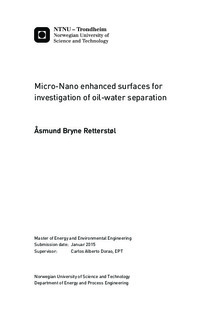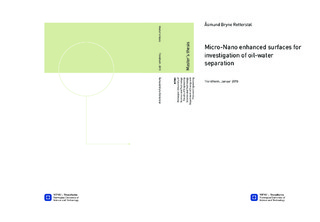| dc.description.abstract | Separator are an important part of the oil processing. The fluid mixture extracted from an oil well contains large amount of water, and is separated by using large separators. A gravitational separator relies on the difference in density to separate the phases. To increase the efficiency of these separators it is important to understand the underlying physics of the of the separation process. This requires experimental work. However, the oil interaction with the with the test cell reduce the visibility of the process.
There were two main objectives in this thesis. One was to investigate the separation of oil water, and the other was to investigate the possibility to control the wettability of the glass surface of the test cell.
The separation time for a mixture of oil and water, depend on both the settling velocity of the droplets and the coalescence time. These depend both, on the properties of the oil and the droplet size. In this thesis focus on the separation time, and the velocity of the droplet interface coalescence. The experiment was conducted by using a small glass vessel, filled with the same amount of oil and water. The liquids were mixed for different amount of time, and the separation was visualized by using a near infrared high-speed camera. Both crude oil-water, and Exxol D80 water mixtures was investigated. The separation velocity of the mixtures was measured by tracking the movement of the interface over time.
The separation velocity of the mixtures did decrease with mixing time. Both for Exxol water and crude oil water. These results were compared with the terminal velocity of a single droplet. The result indicates that the hindering effect of neighboring droplets significantly affect the dynamic of the separation process. Further work is needed to quantify this effect.
The other main objective was to investigate the possibility to control the wettability of the glass surface of the test cell. The wettability of a surface depended on the shape, roughness and energy of the surface. The nano-micro enhanced surfaces were fabricated at the NTNU NanoLab. A thin layer of aluminum and Indium Tin Oxide (ITO) was deposit on different glass samples using a sputtering technic. Different surfaces were created by changing the duration of the sputtering. The roughness of these samples was measured using an Atomic Force Microscope. The surface wettability was then investigated by measuring the contact angle with both oil and water.
The enhanced surfaces did improve the hydrophobic properties, however there was no change in the oleophobic properties. Only one surface in this thesis was hydrophobic, that was an ITO surface that was sputtered for 30 minutes. The hydrophobic properties of the samples, was not just related to the roughness of the surface. This shows that there are other properties that are equally important, such as surface energy and the possibility for air pockets between the surface and liquid. Further work is needed to create a surface for the test cell. The surface energy of the samples should be low to create an oleophobic surface. | |

